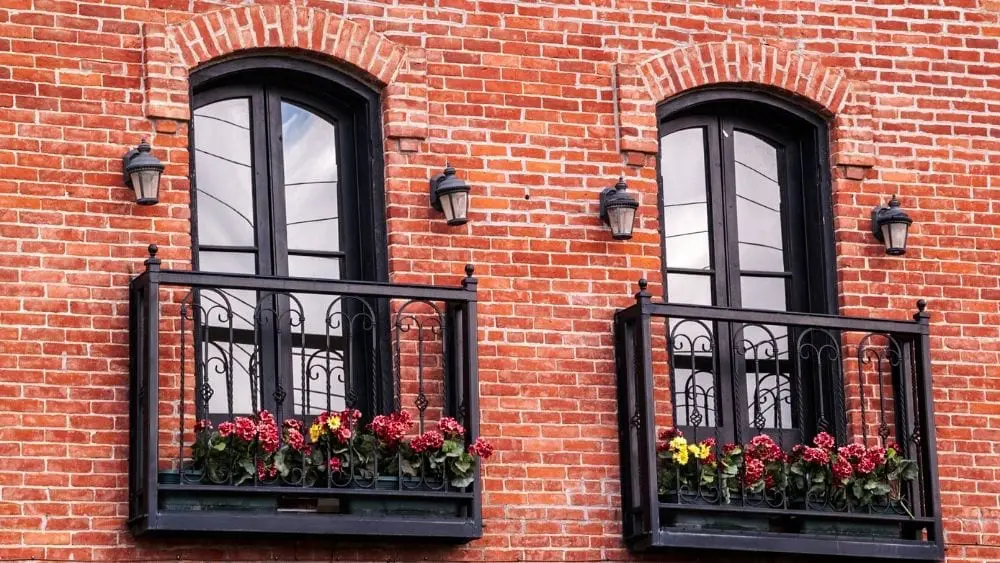
Solar shades, like these from Restoration Hardware, allow you to see the view outside, but filter out UV rays and reduce heat and glare. Photo via Restoration Hardware.
Buyers of newly built homes often cite the abundance of big windows and natural light as a reason to buy new.
Walls of glass, floor-to-ceiling windows, Palladian windows, glass doors and French doors are all appealing, but sometimes those expanses of transparency need to be covered with window treatments.
If you’re looking for privacy or protection from too much sun, you probably also want to enjoy the view and the daylight. Interior designers and window treatment manufacturers have found new ways to meet those needs while adding to the beauty of your home.
“There are plenty of options for window treatments for every budget, so what you choose depends on the style of your home and whether you want a more traditional or contemporary look,” says Randy Bridges, an interior designer and owner of WindowWorks Design in Fort Lauderdale, Fla.
Bridges says manufacturers have created new products including “solar shades” or “screen shades” that allow you to see the view, but have filters to block UV rays and to reduce heat and glare from too much sun.
“In places like Florida and Colorado where the sun can be intense, consumers sometimes don’t realize that they need window treatments to protect their investment in their hardwood floors, their furniture and their artwork,” says Sheri Stoufer, an interior designer and owner of Finishing Touches in Castle Pines, Colo., and Denver, Colo.
Window Walls
One of the challenges of walls of windows is that installing window treatments require some space above or on the sides of the windows where the shades or fabric sits when you want your windows uncovered. Some window treatments can be too heavy to lift and lower because of the required width of coverage.
“Motorized shades work well on big windows,” says Bridges. “You can opt for solar shades that let you see through them, but filter the light and lower the temperature in rooms that get heated up by too much sun.”
In homes where there isn’t space or an outlet for electrical motorized shades, you can use shades that operate on a hidden battery pack. Bridges says the batteries can last as long as two years.
“You can program motorized shades to work together, depending on the light in the room and how you’re using it,” says Bridges.
Bridges also installed sliding fabric panels with roller shades in the same fabric on a wall of windows at a contemporary South Florida condominium.
“Roller shades can be installed with a continuous cord, cordless or motorized and come in lots of different fabrics today so they’re more attractive than the old plain white ones,” says Stoufer. “They have a spring assist now, too, so they work better. One of the least expensive ways to cover big windows is with a roller shade in a decorative fabric. You can also go with a plain shade and layer over it with drapery panels.”
Two-Story and Palladian Windows
While most people hope to keep their Palladian windows uncovered so that their distinctive shape can be visible, sometimes they have to be covered to reduce sun damage or for privacy at night. Stoufer suggests either mounting a rectangular drapery panel over the windows or going with cellular shades, which are thin honeycomb shades.
“Cellular shades are almost like pleated paper, so you can cut them to curve along with the window,” says Stoufer. “You can also run a string up the center for a cord.”
Stoufer says some people opt for stationary window treatments like shutters or custom shades that are either completely shut or completely open.”
Sliding Glass Doors
Sliding glass doors offer accessibility to the outdoors, but sometimes you may want some privacy. The old vertical blinds attached with metal chains that rattle are still around, but now designers recommend using “Vertiglide” cellular shades with a handle that can be pulled across silently or woven wood vertical blinds that filter light and are warmer to look at than traditional vertical blinds.
“If you have enough wall space on the sides of your sliding glass door, you can do draperies,” says Stoufer. “For a more contemporary look, you can use sliding panels of fabric.”
If you have the space above your sliding glass door to mount a window treatment, Stoufer suggests a cellular blind that can be raised and lowered easily since it’s lightweight. You can also motorize blinds on a sliding glass door.
French Doors and Sidelights
These tall and narrow windows can be covered for privacy, although many homeowners opt to leave them uncovered. However, it can sometimes be a problem to mount window treatments on these windows because of a lack of space above or adjacent to the windows, so you may need to look for window treatments with minimal hardware requirements.
“Sheer layers of fabric can be used as blinds for French doors that offer a little privacy and block some of the light,” says Stoufer. “If you want a more streamlined look, you can mount a Roman shade above your French doors. Another option is a cellular shade or, if you need more privacy, a roller shade.”
Bedroom Windows
You may be most concerned about privacy and blocking out light in your bedroom, where Bridges says many people prefer black-out shades.
“Black-out shades aren’t that attractive, so a lot of people are putting ‘ripple fold’ drapery over the shades,” says Bridges. “Ripple fold is the hot new look, very architectural and clean, usually with sheer drapery that looks elegant.”
As you can see, new designs offer plenty of options for homeowners. One thing to keep in mind along with style is safety. Stoufer says a welcome trend in window treatments is the availability of treatments that are cordless to avoid endangering young children.
Whether you need to cover just one over-sized window or a houseful of glass, designers are meeting the challenge with grace and style.

Michele Lerner is an award-winning freelance writer, editor and author who has been writing about real estate, personal finance and business topics for more than two decades.
 Walking the Walk: What to Know About Walkthroughs
Walking the Walk: What to Know About Walkthroughs